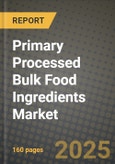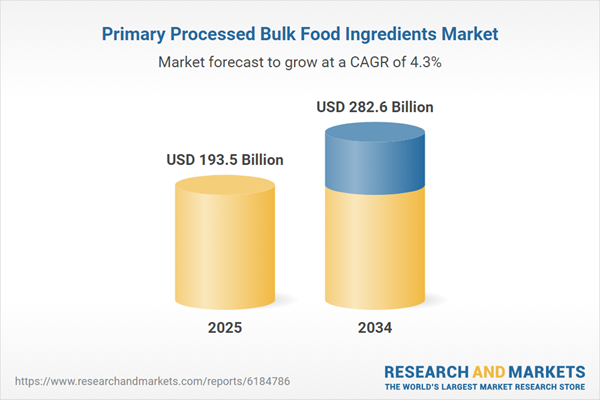Primary Processed Bulk Food Ingredients Market
The primary processed bulk food ingredients market covers foundational inputs - including cereals and pulses (cleaned, milled, rolled), oilseeds and vegetable oils (crushed/refined), sugar and starches, cocoa liquor/butter/powder, coffee and tea (hulled/roasted), dairy powders, salt, and dehydrated fruits/vegetables - supplied in large lots to food, beverage, and foodservice manufacturers. End-uses span bakery, snacks, confectionery, beverages, dairy, meat and alternative proteins, ready meals, sauces, and nutrition/infant applications. The landscape is shaped by origin diversification, risk-managed sourcing, and tighter specifications on microbiology, allergens, and contaminants (mycotoxins, heavy metals). Key trends include sustainability and traceable supply chains (deforestation-free, regen-ag), clean-label and non-GMO/organic streams, carbon footprint reporting at SKU level, and resilience investments in storage, multimodal logistics, and near-shoring. Digitalization is accelerating through e-tendering, predictive demand planning, and quality-data integration from origin to plant gate. Buyers seek functionally consistent lots (protein, moisture, ash), micro-reduce steps via validated kill steps (steam, IR, ozone), and vendor-managed inventory for continuous production. Pricing and margin dynamics remain influenced by climate variability, freight and energy costs, and policy shifts (export controls, biofuel mandates). Competition features global agribusiness majors, ingredient specialists, cooperatives, and regional processors; differentiation rests on scale at origin, blending/formulation capabilities, food-safety culture (GFSI/GMP+), and the ability to deliver segregated, identity-preserved (IP) streams. As brands raise ESG commitments and reformulate for sodium/sugar reduction or fiber/protein enrichment, suppliers that pair commodity reliability with application support (granulation curves, functionality tuning, clean-label processing aids) and credible sustainability claims are best positioned.Primary Processed Bulk Food Ingredients Market Key Insights
- Supply security and origin diversification
- Traceability and ESG as procurement criteria
- Food safety and validated kill steps
- Functional consistency over commodity pricing
- Clean-label and reformulation tailwinds
- Biofuel and alternative-use competition
- Digital procurement and quality data integration
- Processing innovation and value addition
- Logistics redesign and near-shoring
- Risk management and collaborative contracting
Primary Processed Bulk Food Ingredients Market Reginal Analysis
North America
Demand is anchored by large bakery, snack, dairy, beverage, and QSR systems requiring year-round, spec-tight supply. Buyers emphasize traceability, allergen control, and validated kill steps for nuts, seeds, and botanicals. Biofuel policy influences corn and oilseed availability, while rail and inland waterway reliability shapes inventory planning. Near-shoring and regional storage hubs mitigate coastal congestion. Sustainability scorecards and label-friendly reformulations steer mix toward native starches, pulse ingredients, and reduced-sodium salts.Europe
Stringent food-safety and labeling regimes drive rigorous specification management and supplier audits. Sustainability and deforestation-free requirements reconfigure cocoa, palm, and soy supply lines. Energy costs push efficiency upgrades and heat-recovery in drying operations. Demand for organic, non-GMO, and specialty grains remains high, supported by retailer standards. Logistics leverage intermodal and inland terminals, with contingency plans for seasonal river constraints and port labor dynamics.Asia-Pacific
Scale growth comes from expanding packaged foods, beverages, dairy powders, and confectionery, alongside rising quick-commerce channels. Origin proximity to palm, rice, and spices supports competitive sourcing, while weather variability necessitates multi-origin strategies for wheat and pulses. Food-safety upgrades and cold-chain expansion foster higher-spec ingredients. Localization of milling/crush capacity and e-procurement adoption improve responsiveness to demand spikes.Middle East & Africa
Net import reliance heightens sensitivity to freight, currency, and export policy swings. Government procurement and strategic reserves influence flow and pricing. Investments in port grains terminals, silos, and milling capacity improve resilience. Food-safety modernization and halal certification are core requirements. Demand for shelf-stable, heat-tolerant formats (oils, dairy powders, sugar) dominates, with gradual growth in value-added blends.South & Central America
Strong origin positions in soy, corn, sugar, and coffee underpin supply, with value addition through local crush, refining, and roasting. Export logistics and weather seasonality guide shipment programs; internal demand grows with expanding bakery, beverage, and dairy sectors. Certification for sustainability and traceability rises, particularly for coffee and cocoa. Processors balance export premiums with domestic market stability, leveraging cooperatives and regional warehouses for service levels.Primary Processed Bulk Food Ingredients Market Segmentation
By Type
- Grains
- pulses
- and cereals
- Tea
- coffee
- and cocoa
- Nuts
- herbs & spices
- Oilseeds
- Sugar
- Salt
- Others
By Application
- Bakery Products
- Snacks & Spreads
- Ready Meals
- Confectionery Products
- Alcoholic Beverages
- Non-alcoholic Beverages
- Others
Key Market players
Cargill, Archer Daniels Midland (ADM), Bunge, Louis Dreyfus Company (LDC), Olam Group (ofi), Wilmar International, COFCO International, Viterra, CHS Inc., Tereos, Südzucker Group, Associated British Foods (AB Sugar), Barry Callebaut, Ecom Agroindustrial, FonterraPrimary Processed Bulk Food Ingredients Market Analytics
The report employs rigorous tools, including Porter’s Five Forces, value chain mapping, and scenario-based modelling, to assess supply-demand dynamics. Cross-sector influences from parent, derived, and substitute markets are evaluated to identify risks and opportunities. Trade and pricing analytics provide an up-to-date view of international flows, including leading exporters, importers, and regional price trends.Macroeconomic indicators, policy frameworks such as carbon pricing and energy security strategies, and evolving consumer behaviour are considered in forecasting scenarios. Recent deal flows, partnerships, and technology innovations are incorporated to assess their impact on future market performance.
Primary Processed Bulk Food Ingredients Market Competitive Intelligence
The competitive landscape is mapped through proprietary frameworks, profiling leading companies with details on business models, product portfolios, financial performance, and strategic initiatives. Key developments such as mergers & acquisitions, technology collaborations, investment inflows, and regional expansions are analyzed for their competitive impact. The report also identifies emerging players and innovative startups contributing to market disruption.Regional insights highlight the most promising investment destinations, regulatory landscapes, and evolving partnerships across energy and industrial corridors.
Countries Covered
- North America - Primary Processed Bulk Food Ingredients market data and outlook to 2034
- United States
- Canada
- Mexico
- Europe - Primary Processed Bulk Food Ingredients market data and outlook to 2034
- Germany
- United Kingdom
- France
- Italy
- Spain
- BeNeLux
- Russia
- Sweden
- Asia-Pacific - Primary Processed Bulk Food Ingredients market data and outlook to 2034
- China
- Japan
- India
- South Korea
- Australia
- Indonesia
- Malaysia
- Vietnam
- Middle East and Africa - Primary Processed Bulk Food Ingredients market data and outlook to 2034
- Saudi Arabia
- South Africa
- Iran
- UAE
- Egypt
- South and Central America - Primary Processed Bulk Food Ingredients market data and outlook to 2034
- Brazil
- Argentina
- Chile
- Peru
Research Methodology
This study combines primary inputs from industry experts across the Primary Processed Bulk Food Ingredients value chain with secondary data from associations, government publications, trade databases, and company disclosures. Proprietary modeling techniques, including data triangulation, statistical correlation, and scenario planning, are applied to deliver reliable market sizing and forecasting.Key Questions Addressed
- What is the current and forecast market size of the Primary Processed Bulk Food Ingredients industry at global, regional, and country levels?
- Which types, applications, and technologies present the highest growth potential?
- How are supply chains adapting to geopolitical and economic shocks?
- What role do policy frameworks, trade flows, and sustainability targets play in shaping demand?
- Who are the leading players, and how are their strategies evolving in the face of global uncertainty?
- Which regional “hotspots” and customer segments will outpace the market, and what go-to-market and partnership models best support entry and expansion?
- Where are the most investable opportunities - across technology roadmaps, sustainability-linked innovation, and M&A - and what is the best segment to invest over the next 3-5 years?
Your Key Takeaways from the Primary Processed Bulk Food Ingredients Market Report
- Global Primary Processed Bulk Food Ingredients market size and growth projections (CAGR), 2024-2034
- Impact of Russia-Ukraine, Israel-Palestine, and Hamas conflicts on Primary Processed Bulk Food Ingredients trade, costs, and supply chains
- Primary Processed Bulk Food Ingredients market size, share, and outlook across 5 regions and 27 countries, 2023-2034
- Primary Processed Bulk Food Ingredients market size, CAGR, and market share of key products, applications, and end-user verticals, 2023-2034
- Short- and long-term Primary Processed Bulk Food Ingredients market trends, drivers, restraints, and opportunities
- Porter’s Five Forces analysis, technological developments, and Primary Processed Bulk Food Ingredients supply chain analysis
- Primary Processed Bulk Food Ingredients trade analysis, Primary Processed Bulk Food Ingredients market price analysis, and Primary Processed Bulk Food Ingredients supply/demand dynamics
- Profiles of 5 leading companies - overview, key strategies, financials, and products
- Latest Primary Processed Bulk Food Ingredients market news and developments
Additional Support
With the purchase of this report, you will receive:- An updated PDF report and an MS Excel data workbook containing all market tables and figures for easy analysis.
- 7-day post-sale analyst support for clarifications and in-scope supplementary data, ensuring the deliverable aligns precisely with your requirements.
- Complimentary report update to incorporate the latest available data and the impact of recent market developments.
This product will be delivered within 1-3 business days.
Table of Contents
Companies Mentioned
- Cargill
- Archer Daniels Midland (ADM)
- Bunge
- Louis Dreyfus Company (LDC)
- Olam Group (ofi)
- Wilmar International
- COFCO International
- Viterra
- CHS Inc.
- Tereos
- Südzucker Group
- Associated British Foods (AB Sugar)
- Barry Callebaut
- Ecom Agroindustrial
- Fonterra
Table Information
| Report Attribute | Details |
|---|---|
| No. of Pages | 160 |
| Published | November 2025 |
| Forecast Period | 2025 - 2034 |
| Estimated Market Value ( USD | $ 193.5 Billion |
| Forecasted Market Value ( USD | $ 282.6 Billion |
| Compound Annual Growth Rate | 4.3% |
| Regions Covered | Global |
| No. of Companies Mentioned | 15 |









